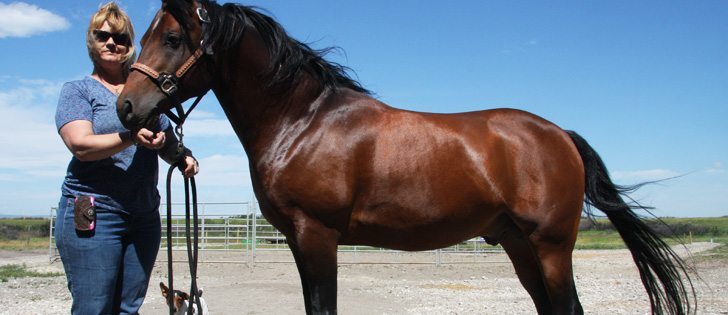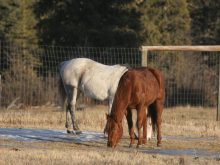The RCMP has been breeding its own horses for more than a century and has high standards for what the Musical Ride requires
Glacier FarmMedia – It’s an image quintessential to the Royal Canadian Mounted Police — a rider in a red coat and black belt, calf-high brown boots, broad-brimmed hat, mounted on a black horse.
That visual has been around for well over a century, dating back to when the organization was still known as the North West Mounted Police. In former days, the force wasn’t so picky about what type of horse the Mounties rode. It was only in 1939, after the appointment of S. T. Wood as commissioner, that colour began to matter.
Wood had seen how the striking red uniform of the British army’s Household Cavalry Life Guards appeared against their black horses during the coronation of King George VI, and he liked the look.
Read Also

Students urged to consider veterinary medicine
Alberta government makes $86.5 million investment in University of Calgary to double capacity for its veterinary medicine program to address labour shortages in the field.
With that, the RCMP’s in-house horse breeding program was born. The breeding farm was located in Fort Walsh, Sask., until 1968, when it moved to its current location in Pakenham, Ont.

Today, the horses are no longer part of daily policing duties, but they’re an iconic part of the RCMP Musical Ride. They also appear on ceremonial occasions, pull carriages and perform other state duties.
But while the purpose of the horses has shifted, the RCMP’s requirements for their look have not.
For most of its history, the program was based on black thoroughbreds. In 1989, the RCMP brought in Hanoverian stock with an aim of incorporating greater colour and substance.
Today, the program is a noted Hanoverian breeder, highly organized and closed to the public.
“We’re a very unique equine breeder,” said Karen Ryan, manager of the RCMP Musical Ride breeding farm. “So, our sole mandate is to breed horses for the sole use of the RCMP Musical Ride. We do not breed horses to sell. That’s not our intention.”
However, some animals do make their way into public hands. Each year, near the end of September, there is an open auction of surplus horses. Not every horse that comes out of the program is deemed acceptable to the RCMP’s exacting standards, and horses may fall short of the mark on colour, size or temperament, or may be retired mares.
Once sold, those horses can serve as companion animals or even top-level competition horses.
“We’ve had them go all the way out to (the) West Coast, and then all the way to the East Coast, and we’ve also had them go down to the States. They go all over,” Ryan said.
Hanoverians are performance oriented, known for clean lines and well-developed muscles. They also have a reputation as exceptional riding and sport horses. For the RCMP, horses must also be:
• Sixteen to 16.3 hands high.
• Black, with the only allowable exceptions of a white star or blaze and minor white on the legs.
• Noted for a friendly, approachable temperament.
• Have good ride ability.
“Our goal is to constantly improve conformation, ride ability, temperament — everything,” Ryan said. “We have a breeding committee, which we meet at the beginning of every year, and we do selection breeding pairings and we look at all the past lineage for every mare. We look at every stallion and we do our best to pair them up with the stock we have, including our frozen semen stock.”
Evaluation starts just days after foals are born and continues until the horses are put under saddle. Each has a file with notes from trainers and breeding staff that highlight their abilities and personality.
Basic training lasts until they’re three years old. Those years are spent at the breeding farm undergoing horsemanship and ground training.
Staff don’t ride them during that time, although the horses are taught how to lead, get on a trailer and stand for the farrier and vet. Young horses are also taken through obstacle courses that include walking over and around pool noodles, exercise balls and fences to desensitize them to unusual stimuli.
These various activities provide staff with insight on which horses will have the right temperament and fluidity for the Musical Ride. Over those first three years, the primary training team for the Musical Ride also comes from Ottawa to assess progress.
When this initial set of training is complete, horses report for duty in Ottawa and are trained for the saddle.
“We call it sending them off to school,” Ryan said. “We send our babies off to kindergarten, and they start their remount training there. And it’s a three-year process there.
“Usually, by six years old, that’s when they want them to join up on the Musical Ride. That’s usually when they’re going to be ready. However, they have had them on the ride as early as five years old.”
Sometimes, the Musical Ride isn’t a calling, and the horse may move to another area within the program. The most significant reason for this shift is often height. Having a horse that is too short or too tall affects the uniformity of the ride’s appearance and makes it difficult for the horse to fluidly perform the choreography.
Less ideally sized horses may become program training horses, assisting in the training of constables, or could perform regimental duties like processions, state funerals, royal visits and the carriage unit. Other times, they will go back to the breeding program.
The program tries to retain all the horses possible to minimize the number sent to auction.
“Horses aren’t cookie cutter. They all have their own personality, and you can’t make them like what they’re doing. There are a few who just aren’t a good fit for the ride,” Ryan said.
This year’s auction had five horses up for sale, each of them chestnuts ranging from three months to 17 months old. There is little fear, historically speaking, that those horses won’t find a market.
Ryan shared the story of one mare that was 23 years old, retired from the Musical Ride, which was put up for sale. Program staff didn’t expect her to sell, but a woman in her late 70s put in a winning bid because she wanted a horse for light pasture rides.
Other horses go above and beyond expectations. Ryan said many people who purchase a horse remain in touch with her and provide updates.
“It just warms my heart every time I receive one of those pictures or an update.”
Some horses bred in the program have gone on to perform well in equestrian competitions.

Though individuals can’t be named for privacy purposes, Ryan said she knows of several who have progressed to elite competitions. One is competing at the advanced level, a few others have been in the Olympics and others have been at the top level in the Royal Agricultural Winter Fair in Toronto.
Ursula Hosking, Canadian Hanoverian Society chair, said the closed nature of the RCMP’s program means it has made only a small long-term impact to the Hanoverian industry. While the auction is open, and provides a good resource for young stock and mares, the biggest impact would come from creating greater stallion availability.
“Mostly, they’re just breeding for themselves, and they have their own stallions that only they use,” she said. “Like, their stallions aren’t generally available to the public because they’re all government run.”
There are relatively few Hanoverian stallions available for breeding in Canada, she added. Most are busy competing. Frozen semen from overseas is commonly used because the bigger Hanoverian population resides in Europe.
The RCMP’s program has the advantage of a readily available stallion supply.
The most significant effect the program has had on the industry in recent history was the stallion Sir Wanabi, whose sire was the RCMP stallion Santorini. He was born in 2002 and had been sold as a scrawny yearling but quickly grew successful and was highly sought in the Hanoverian community for his reputation as a beautiful, level-headed horse.
In particular, Hosking noted, he became a popular sire for hunter jumper breeders.
The RCMP program has brought more general awareness of the breed, she added.
“They’re a really good ambassador for the breed and we’re very proud that the RCMP breeds Hanoverians.”
















